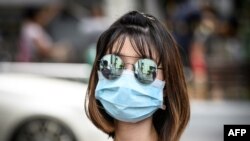Spring is in the air across the Northern Hemisphere. As winter is winding down, some are expecting the COVID-19 pandemic to fade along with it.
Last month, President Donald Trump predicted that the pandemic would end in April, as warmer temperatures move in. Others have speculated that heat and humidity have kept case counts relatively low in the tropics.
It's possible.
However, "It's probably not something I'd put a lot of money on either way," George Washington University arbovirologist Christopher Mores said.
In temperate countries, colds and flu rise and fall with the seasons. The COVID-19 virus is a respiratory disease much like the flu, and it's closely related to coronaviruses that cause the common cold.
Based on how those other coronaviruses behave, one group of scientists predicts that COVID-19 cases may decline as Northern Hemisphere spring arrives.
But that won't mean the virus is beaten. Their models show illnesses spiking again next winter.
The hot, humid zone
Scientists don't know all the reasons why colds and flu are seasonal, but one thought is that the viruses spread more easily when the air is dry, as it generally is in winter.
But humidity doesn't seem to matter much to the COVID virus, according to another group of researchers. They found the virus spread in many regions across China, from the cold, dry north to the warm, humid south.
And then there's Singapore, a hot, humid country where transmission is ongoing.
Heat and humidity don't completely stop the flu, either. Some studies show transmission declines closer to the equator, but influenza is still a major cause of hospitalization and death. And during the 2009 H1N1 influenza pandemic, tropical Mexico, India, Bangladesh, Myanmar, Indonesia, and Guatemala were among the countries with the highest death rates.
Schools of viruses
The weather is not the only reason that flu declines in the Northern Hemisphere in summer. The school year plays a role, too.
Cases of flu, chicken pox, measles and other respiratory diseases go up during the school year, said Mark Lipsitch, director of the Harvard University Center for Communicable Disease Dynamics. When school is out for the summer, cases go back down.
A growing number of school districts are canceling classes in an effort to contain the virus. It's not clear how much it will help, however.
While most children don't seem to get severe cases of COVID-19, they may still be spreading the virus. It's unknown how significant a role they play in the epidemic.
"Understanding this is key if we want to know whether school closures can help control COVID-19 spread, as well as to anticipate how much summer vacation may help reduce spread," Lipsitch wrote on his center's website.
Return visitor
Another reason the COVID-19 pandemic may not soon disappear, Lipsitch wrote: "New viruses have a temporary but important advantage – few or no individuals in the population are immune to them."
That means not much will hold them back, even if the weather is not as favorable to them.
If the virus does slow down for the summer, it may come back in the fall. And perhaps the fall after that. Depending in part on how long immunity lasts in patients who are infected and recover, COVID-19 could become a regular visitor, according to a study Lipsitch co-authored.
That makes developing vaccines and treatments all the more important.









